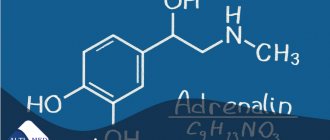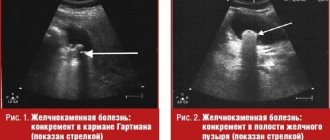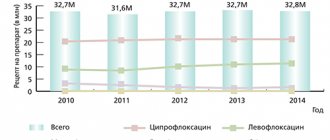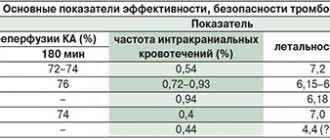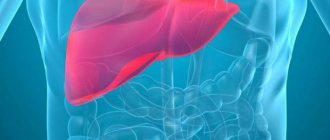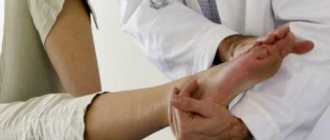Tizanidine-teva
Manufacturer: TEVA Pharmaceutical Industries Ltd. (Israel)
tab. 4 mg: 20, 30, 50 or 100 pcs. Reg. No.: LP-001812
Clinical and pharmacological group:
Centrally acting muscle relaxant
Release form, composition and packaging
Pills
round, biconvex, white or off-white, with a cross-shaped mark on one side and “T4” engraving on the other.
| 1 tab. | |
| tizanidine | 4 mg |
Excipients:
lactose anhydrous 115.82 mg, prosolv (microcrystalline cellulose 98%, colloidal silicon dioxide 2%) SMCC 50 45.15 mg, stearic acid 4.3 mg, prosolv (microcrystalline cellulose 98%, colloidal silicon dioxide 2%) SMCC 90 45.15 mg.
10 pieces. - blisters (2) - cardboard packs. 10 pieces. - blisters (3) - cardboard packs. 10 pieces. - blisters (5) - cardboard packs. 10 pieces. - blisters (10) - cardboard packs.
Description of the active components of the drug "Tizanidine"
pharmachologic effect
Centrally acting muscle relaxant. Reduces increased tone of skeletal muscles, relieves their spasm; reduces muscle resistance during passive movements, increases the strength of voluntary contractions. The muscle-relaxing effect of tizanidine is probably due to inhibition of spinal polysynaptic reflexes, which is associated with a decrease in the release of excitatory amino acids from the presynaptic terminals of spinal interneurons, as well as stimulation of α2-adrenergic receptors. Tizanidine does not affect the transmission of excitation at neuromuscular synapses.
Indications
Spastic condition of skeletal muscles caused by neurological diseases (multiple sclerosis, chronic myelopathy, stroke, degenerative diseases of the spinal cord). Painful spasm of skeletal muscles caused by damage to the spine (cervical and lumbar syndromes) or occurring after surgery (for a herniated disc or osteoarthritis of the hip).
Dosage regimen
To stop painful spasms of skeletal muscles, use 2-4 mg 3 times a day; in severe cases, it is additionally recommended to take 2-4 mg at night. For spastic muscle conditions caused by neurological diseases, the initial dose is 6 mg/day in 3 divided doses. The dose is gradually increased by 2-4 mg/day every 3-7 days. The optimal therapeutic effect is usually achieved at a dose of 12-24 mg/day, divided into 3-4 doses. The dose should not exceed 36 mg/day.
Side effect
When using tizanidine in relatively small doses in rare cases
drowsiness, a feeling of fatigue, dizziness, dry mouth, nausea, and a slight decrease in blood pressure are observed;
in higher doses
- these effects occur more often and are more pronounced, in addition, insomnia, muscle weakness, bradycardia, and increased transaminase activity in the serum are possible.
Contraindications
Hypersensitivity to tizanidine.
Use for liver dysfunction
Use with caution in patients with impaired liver function.
Use for renal impairment
Use with caution in patients with impaired renal function.
special instructions
Use with caution in patients with impaired liver and kidney function.
Impact on the ability to drive vehicles and operate machinery
At the beginning of treatment, if drowsiness occurs, activities that require a high concentration of attention and rapid psychomotor reactions should be avoided.
Drug interactions
When used simultaneously with antihypertensive drugs (including diuretics), severe arterial hypotension and bradycardia may develop.
With the simultaneous use of ethanol and drugs with a sedative effect, the sedative effect increases.
Drug interactions
When used simultaneously with antihypertensive drugs (including diuretics), severe arterial hypotension and bradycardia may develop.
With the simultaneous use of ethanol and drugs with a sedative effect, the sedative effect increases.
Pathogenetic and clinical significance of tizanidine in the treatment of ankylosing spondylitis
Ankylosing spondylitis (AS) is the main form of inflammatory diseases of the spine and occupies a leading position among other spondyloarthritis. AS is characterized by a chronic progressive course and leads to ankylosis of the iliosacral and intervertebral joints, calcification of the spinal ligaments and limited mobility of the spine, causing early disability in patients.
The spectrum of pathological changes in AS is not limited only to the involvement of the axial skeleton. It is characterized by arthritis of peripheral joints (asymmetric oligoarthritis), primarily of the hip, knee, ankle and shoulder joints, which is observed in every third patient. Enthesitis in AS, one of the most typical manifestations of all spondyloarthritis, occurs in 25–40% of patients, while the Achilles tendon, plantar fascia, connection of the manubrium with the body of the sternum, pubic symphysis, area of attachment of ligaments to the spinous processes are most often involved in the pathological process , trochanters of the femur, patella, clavicles and calcaneus (attachment site of the Achilles tendon and plantar aponeurosis) [1]. Osteoporosis of the spine often occurs, which leads to fractures in young patients [2]. Systemic manifestations are characterized by damage to the heart (aortitis, the formation of organic heart defects (1–10%), disturbances of rhythm and cardiac conduction, as well as a relatively high risk of developing atherosclerosis of the coronary and other vessels), lungs (restrictive and obstructive respiratory failure, apical pulmonary fibrosis) , kidneys (IgA nephropathy, AA amyloidosis), eyes (acute anterior uveitis in 25–30% of patients with acute pain, decreased visual acuity, subsequent formation of synechiae and glaucoma) [3].
AS usually begins at a young age, and its development after the age of 45 is extremely rare. The average age of onset of this disease is 24 years [4]. This disease is more common in men, but is often observed in women, although in them it is usually more benign and does not lead to significant deformation of the spine. Some authors, on the contrary, do not find significant differences in the clinical manifestations and course of this disease depending on the gender of the patients. If we take into account all cases of AS, including its latent course, the ratio of men to women is 2:1–3:1. The prevalence of AS is associated with the frequency of occurrence of the HLA-B27 antigen in the population and varies widely - from 0.15% in Finland to 1.4% in Norway and even up to 2.5% among the adult population of Alaskan Eskimos, but overall is 1 :200 of the adult population, i.e., 0.05% [5].
Considering various aspects of spondyloarthritis, their late diagnosis attracts attention. This circumstance makes it difficult to carry out adequate pathogenetic therapy in a timely manner. Globally, a reliable diagnosis of AS is established in men on average 8.4 years, and in women only 9.8 years after the onset of the first symptoms of the disease [4]. Domestic researchers obtained similar data [6]. Late diagnosis of AS is due to the low level of awareness of primary care physicians about the features of clinical manifestations and clinical heterogeneity of AS and other spondyloarthritis.
Generally accepted diagnostic criteria are of primary importance in diagnosing AS, but other characteristic manifestations must also be taken into account. When diagnosing AS, one should keep in mind the possibility of its subclinical course, the gradual onset of the disease in young people, the high incidence of men, asymmetric mono- or oligoarthritis of the medium and large joints of the lower extremities, pain on palpation of the lumbosacral joints, a feeling of stiffness in the lower back, early signs of bilateral sacroiliitis (radiographic or magnetic resonance imaging (MRI)). Incorrect diagnosis is largely associated with the late appearance of characteristic radiographic changes in the sacroiliac joints and spine, with difficulty in interpreting them, as well as with incorrect interpretation of the existing symptoms of the musculoskeletal system or systemic manifestations, as well as inflammatory pain in the spine - one of the most informative symptom complexes of this disease. With the advent of MRI, it became possible to early diagnose AS before the appearance of its radiological stigmata and, above all, sacroiliitis.
In spondyloarthritis, there is a commonality of morphological changes, an association with HLA-B27 and a similarity in response to drugs. Thus, in such diseases, there is a higher effectiveness of local therapy with glucocorticoids compared to systemic use and low effectiveness of pulse therapy with ultra-high doses of metipred, the ineffectiveness of methotrexate, as well as other immunosuppressants in AS, and only the symptomatic effect of methotrexate in psoriatic arthritis without its active effect on radiographic progression of arthritis and spondylitis.
What explains the above features? They are primarily associated with the interest of entheses. Currently, the enthesis is considered as an independent organ with peculiarities of pathomorphology and immunology and high metabolic activity. Both in AS and spondyloarthritis, the primary and main springboard of the pathological process is entheses and bone with the development of enthesitis and osteitis, and synovitis is considered as a consequence of the spread of the pathological process to the synovial membrane, i.e. it is secondary to the affected entheses [7 ]. It has been shown that already at an early stage of enthesitis development there are macrophage and inflammatory infiltrates with a large number of T-lymphocytes, which are localized in the nearby fibrocartilage and, to a lesser extent, in the bone. With AS, enthesitis is observed both in the periphery and in the spine, and coxitis and the formation of syndesmophytes can be considered as a particular variant of common enthesopathy.
Peculiarities of the pathomorphology of AS are also associated with the characteristics of patients’ response to medications. Essentially, there are no basic anti-inflammatory drugs used for this disease, except for sulfasalazine, which has a small positive effect on arthritis of peripheral joints, but not on inflammation in the spine. In this regard, symptomatic drugs, primarily nonsteroidal anti-inflammatory drugs (NSAIDs), become especially important. NSAIDs for AS not only reduce pain in the spine and joints and reduce inflammatory activity, but also inhibit radiological progression in the axial skeleton [8, 9]. A prospective study examined the effect of long-term NSAID therapy on the dynamics of radiological changes in 215 patients who took celecoxib 200 mg/day for 52 weeks. It turned out that in patients who regularly took celecoxib, the X-ray dynamics in the spine were 4 times less pronounced compared to the group of patients taking NSAIDs at their own discretion. In another study of 150 patients with AS, radiological progression according to the mSASSS index was almost 4 times less in the group of continuous NSAIDs compared with the on-demand NSAIDs group, while the drug was taken for 2 years. These data are of great interest and allow us to consider NSAIDs in AS as a means of pathogenic action, which is not observed in rheumatoid arthritis or any other diseases of the musculoskeletal system.
In AS, pronounced heterogeneity and diversity of course are observed. However, the clinical picture is dominated by two main manifestations - inflammatory pain and rigidity. According to the criteria of the International Society for SpondyloArthritis (The Assessment of SpondyloArthritis international Society, ASAS, 2009), inflammatory type pain in the back is characterized by a gradual onset, its development before reaching 40 years of age, a decrease after physical activity, no improvement at rest and pain in the back. night hours [10]. The dynamics of inflammatory pain in the spine is one of the criteria for response to therapy and a criterion for remission of this disease.
The causes of pain in AS are inflammatory changes in the peripheral, root and sacroiliac joints, as well as in the intervertebral joints, vertebral bodies, spinal ligaments, intervertebral discs (discitis). Radicular pain may be caused by compression due to spinal deformation. As is known, all structures of the spinal column, with the exception of bone tissue, contain nerve endings and can cause pain [5]. Free nerve endings that function as pain receptors have been identified in the capsules of the intervertebral joints, the posterior longitudinal and interspinous ligaments, the vertebral periosteum, the walls of arterioles and veins, the vessels of the paravertebral muscles, and the outer third of the fibrous ring of the intervertebral discs.
Dorsalgia in this disease can be a manifestation of vertebrogenic radicular syndrome (radiculopathy) or reflex pain syndromes. There are other possible reasons for the development of dorsalgia in AS, such as spondylolisthesis, osteoporosis, or failure of the structures that ensure the vertical position of the body. The causes of spinal canal stenosis in AS can be posterior osteophytes, herniated intervertebral discs, secondary arthrosis of the intervertebral (facet joints), and spondylosis.
Equally important is rigidity or stiffness. At the onset of the disease, this symptom is determined only in the lower back and subsequently spreads to the entire axial skeleton. Stiffness is usually observed in the early morning hours, but in some patients with high activity of the inflammatory process it lasts throughout the day. The intensity and duration of rigidity usually corresponds to the intensity of pain in the joints and spine, emphasizing their common genesis. The presence of an inflammatory process in the spine causes reflex tension in the back muscles, which, in turn, leads to changes in posture and deformation of the spine (physiological lordosis in the lumbar spine is leveled, kyphosis of the thoracic spine is emphasized and hyperlordosis of the cervical spine develops). In advanced cases, a “petitioner pose” characteristic of patients with AS is formed with a positive Forestier symptom, high values of the Thomayer test and a significant impairment of the functional ability of the spine. Spinal deformity is supported not only by structural changes in the joints of the spine, its ligaments and directly in the vertebral bodies, but also by hypertonicity of the back muscles.
The severity and duration of rigidity adequately reflects the activity of the inflammatory process in AS, and to a greater extent than such generally accepted laboratory tests as erythrocyte sedimentation rate (ESR) and the level of C-reactive protein, and its dynamics, like the dynamics of pain, are of great importance in assessing the effectiveness of the therapy. Analysis of these two main symptoms is important for assessing the inflammatory activity of AS, since in this disease there are no adequate laboratory tests for its determination, and the values of acute phase reactants do not always coincide with the severity of tissue changes. Currently, the main tool for assessing the activity of AS is the BASDAI index (Bath Ankylosing Spondylitis Disease Activity Index), which includes 6 points, 5 of which relate to the severity of pain, as well as the severity and duration of morning rigidity. The intensity and duration of rigidity usually corresponds to the intensity of pain in the joints and spine, emphasizing their common origin.
Rigidity and activity of ankylosing spondylitis:
- rigidity, along with pain in the spine, is the most characteristic symptom of AS;
- There is a close relationship between pain and stiffness in the spine;
- stiffness in the lumbar spine is an early symptom of AS; this sign better reflects inflammatory activity than ESR and acute phase reactants;
- The duration of morning stiffness and its severity are included in the BASDAI index (AS Activity Index).
With AS, reflex (muscular-tonic) syndromes often occur, which are caused by irritation of receptors in response to changes in the discs, ligaments and joints of the spine. Impulses from the receptors reach the motor neurons of the spinal cord, which is accompanied by an increase in the tone of the corresponding muscles. One of the symptoms of such dysfunction is the “reins” symptom, caused by spasm of the long back muscles. Spasmed muscles lead to limited mobility of a certain segment of the spine, and also become a secondary source of pain, triggering a vicious circle of “pain - muscle spasm - pain” and contributing to the formation of myofascial syndrome. It should be noted that hypertonicity of striated muscles also takes part in the genesis of the development of contractures and muscle fibrosis. Some authors consider increased muscle tone as one of the risk factors for the rapid progression of functional spinal insufficiency in this disease. The importance of the muscular-tonic component in AS is evidenced by the good results of epidural anesthesia, which leads to a significant increase in the range of motion in the spine even in functionally hopeless patients. It should be noted that severe and prolonged rigidity is considered a risk factor for the unfavorable course of AS, as well as a factor contributing to the chronicity of pain:
- rigidity (stiffness) is a characteristic sign of inflammatory and (to a lesser extent) degenerative diseases of the joints and spine;
- the intensity and duration of rigidity usually corresponds to the intensity of pain in the joints and spine, emphasizing their common genesis;
- there is a close relationship and interdependence between rigidity and pain;
- stiffness has a significant impact on the functional state of the musculoskeletal system;
- the dynamics of this indicator allows us to judge the effectiveness of the therapy;
- increased muscle tone is considered as one of the risk factors for the rapid progression of the disease and its unfavorable prognosis.
Rigidity and hypertonicity of muscles in AS contribute to:
- spinal deformities;
- the formation of a “supplicant pose” and a “board-shaped” back;
- static disturbances, changes in gait;
- formation of flexion contractures of the hip and other joints;
- limited mobility of the spine and reduced range of active movements;
- early disability of patients.
To relieve rigidity or significantly reduce its intensity and duration, muscle relaxants are used. In addition, they reduce muscle hypertonicity and reduce tonic muscle tension, which helps reduce pain and increase range of motion in the joints and spine. Patients with AS also experience reflex muscle tension, which, in turn, further contributes to the limitation of spinal mobility, caused primarily by structural changes. In these cases, the use of muscle relaxants increases the range of motion in the spine and peripheral joints, which makes their use advisable. It should be noted that reflex muscle tension creates unfavorable conditions for the blood supply to tissues, which contributes to the aggravation of metabolic disorders.
Tizanidine (Sirdalud) occupies a special place among muscle relaxants. It is an effective drug for the treatment of muscular-tonic syndromes and myofascial pain syndrome, spasticity of various origins [11]. Sirdalud is a centrally acting muscle relaxant and is an α2-adrenergic receptor agonist. The drug realizes its effect at the spinal and supraspinal levels. Tizanidine reduces muscle tone due to its stimulating effect on the monoaminergic nuclei of the brain stem. This leads to inhibition of polysynaptic reflexes of the spinal cord responsible for muscle hypertonicity and suppression of the transmission of excitation through them, which causes a decrease in the increased tone of the flexor and extensor muscles and a decrease in painful muscle spasms [12].
A feature of this drug is a combination of muscle relaxant and analgesic effects, while the reduction in pain is due not only to muscle relaxation, but also to a direct central analgesic effect [13]. It is believed that it is based on an indirect antinociceptive effect carried out through the non-opioid neuronal system. Accustomment to the analgesic effect of the drug does not develop with long-term use.
Therapeutic effects of Sirdalud:
- reduces the duration and severity of morning stiffness;
- reduces reflex muscle spasm, hypertonicity and spasticity;
- does not have a negative effect on muscle strength;
- increases range of motion;
- when prescribed early, it prevents irreversible deformations of the osteoarticular apparatus and the development of contractures;
- increases the daily activity of patients and improves their quality of life.
In addition, tizanidine also has anti-inflammatory activity and potentiates the effect of NSAIDs [14].
In Russia, tizanidine is registered under the name Sirdalud. Tizanidine is administered orally at a dose of 2–4 mg 3 times a day. The daily dose is selected individually, and treatment should always be started with small doses. For AS, as a rule, no more than 4 mg/day is used. For severe morning stiffness, it is advisable to prescribe an additional 2 or 4 mg at night. There is a dosage form of tizanidine in the form of modified-release capsules (Sirdalud MR) at a dose of 6 mg. A more striking therapeutic effect is observed with the simultaneous administration of muscle relaxants with NSAIDs, especially since such combination therapy reduces the risk of developing adverse effects of NSAIDs. The age and gender of patients, as well as food intake, do not affect the pharmacokinetics of Sirdalud.
Thiazanidine reduces muscle tone, reducing only its tonic component, which helps maintain, and in some cases increase, muscle strength. This distinguishes it from tolperisone and baclosan, which do not have these properties. Thanks to this feature and distinct analgesic effect, Sirdalud increases the daily activity of patients and improves their quality of life.
Therapeutic effects of Sirdalud:
- characterized by a pronounced analgesic effect;
- potentiates the anti-inflammatory and analgesic activity of NSAIDs;
- reduces the daily need for NSAIDs and analgesics;
- improves tolerability of NSAIDs and analgesics;
- against the background of Sirdalud, good treatment results are significantly more often observed;
- reduces the severity of symptoms of autonomic dysfunction;
- has a mild sedative effect and helps normalize sleep;
- has gastroprotective properties.
If the drug is suddenly discontinued, some increase in muscle tone may occur, so withdrawal should be gradual. Rebound syndrome is also observed with rapid withdrawal of some other muscle relaxants.
The gastroprotective effect of the drug seems interesting, which is associated with its adrenergic activity [15]. This is all the more important because patients with AS almost constantly take NSAIDs and often develop drug-induced gastropathy and enteropathy, increased blood pressure and other cardiac symptoms, gastro- and nephrotoxicity. It has been established that Sirdalud improves the tolerability of NSAIDs, in particular diclofenac, and enhances their analgesic effect. The use of piroxicam, diflunisal and diclofenac in combination with tizanidine (4 mg/day), prescribed for 10–12 days, showed a significant reduction in pain and improvement in spinal mobility in the latter group. At the same time, the scores of the Oswestry questionnaires recommended by the World Health Organization for patients with back pain improved by 25%, and the visual analogue scale (VAS) decreased from 56 mm to 34 mm. Tolerability of diclofenac and tizanidine when used in combination was good [16].
Evidence of the gastroprotective effect of tizanidine was also obtained in a multicenter randomized clinical trial in which 405 patients participated. Gastropathy was detected in 12% of patients receiving a combination of diclofenac and tizanidine, and in 32% of patients receiving diclofenac and placebo [17]. In a multicenter, double-blind study, the combination of tizanidine with ibuprofen was significantly superior to the combination of placebo with ibuprofen and ibuprofen monotherapy in patients with low back pain [18].
Sirdalud in small doses rarely leads to adverse reactions. In addition to drowsiness, lethargy and decreased concentration, dizziness, drowsiness, dry mouth, increased fatigue, intestinal dyspepsia and, extremely rarely, increased hepatic aminotransferases may be observed. While taking Sirdalud, a moderate decrease in blood pressure is possible, especially since it is able to potentiate antihypertensive drugs. A decrease in blood pressure is also observed in patients taking CYP1A inhibitors, such as ciprofloxacin, simultaneously with Sirdalud. Possible sleep disorders, insomnia, bradycardia, heart rhythm disturbances, prolongation of the QT interval. But in general, the drug is well tolerated both in short-term and long-term use, and the adverse events that occur are transient and do not lead to its withdrawal. Sirdalud, unlike other muscle relaxants, does not cause muscle weakness, which is its great advantage, and is generally better tolerated [14].
Thus, the prescription of Sirdalud for AS promotes rapid regression of pain and rigidity in both the spine and peripheral joints, improvement of spinal mobility, and a significant reduction in the likelihood of developing contractures and muscle atrophies in this disease. Reducing reflex muscle tension improves motor functions and facilitates rehabilitation measures.
Literature
- Maksymowych W., Mallon C., Morrow et al. Development and validation of the Spondyloarthritis Research Consortium of Canada (SPARCC) enthesitis index // Ann Rheum Dis. 2009; 68:948–953.
- Van Der Weijden M., Claushuis T., Nazari T. et al. High prevalence of low bone mineral density in patients within 10 years of onset of ankylosing spondylitis: a systematic review // Clin Rheumatol. 2012 (epub ahead of print).
- Van der Horst-Bruinsma IE, Nurmohamed MT Management and Evaluation of Extra-articular Manifestations in Spondyloarthritis // Ther Adv Musculoskel Dis. 2012; 4 (6): 413–422.
- Kahn MA Ankylosing spondylitis: the facts. Oxford medical publications, 2002.
- Sieper J., Braun J., Rudwaleit M. et al. Ankylosing spondylitis: an overview // Ann. Rheum. Dis. 2002; 61(Suppl III): 8–18.
- Dubinina T.V. Inflammatory back pain and diagnosis of spondyloarthritis in clinical practice. Abstract of Ph.D. diss. M., 2011.
- Mc Gonagle D., Khan MA, Mazzo-Ortega H. Enthesitis in spondyloarthropathy // Curr Opin Rheum. 1999; 11: 244–250.
- Wanders A., van der Heijde D., Landewe R. et al. Nonsteroidal anti-inflammatory drugs reduce radiographic progression in patients with ankylosing spondylitis // Arthritis Rheum. 2005; 52:1756–1765.
- Van der Heijde D., Baraf HSB, Ramos-Remus C. et al. Evaluation of the efficacy of etoricoxib in ankylosing spondylitis: results of a fifty-two-week, randomized, controlled study // Arthritis Rheum. 2005; 52:1205–1216.
- Rudwaleit M., van der Heijde D., Landewe R. et al. The development of Assessment of SpondyloArthritis international Society classification criteria for axial spondyloarthritis (part II): validation and final selection // Ann Rheum Dis. 2009; 68(6):777–783.
- Coward DM Tizanidine: Neuropharmacology and mechanism of action // Neurology. 1994; 44, 11 (Suppl. 9): 6–11.
- Danilov A. B. Possibilities of using tizanidine (Sirdaluda) in clinical practice. Literature review // RMJ. 2009; 20: 1370–1375.
- Shirokov E. A. Syndrome of increased muscle tone in the practice of a neurologist and its treatment with Sirdalud // Russian Medical Journal. 2005. No. 22. T. 13, 1466–1468.
- Ushkalova E. A. Centrally acting muscle relaxant tizanidine in clinical practice // Consilium medicus. 2005; 7(8):681–683.
- Emre M. The gastroprotective effects of Tizanidine: an overview // Current Therapeutic Research. 1998; 59 (1): 2–12.
- Nasonova V. A. Pain in the lower back is a major medical and social problem, methods of treatment // Consilium medicus. 2004; 6(8):536–541.
- Sirdalud Ternelin Asia-Pacific Study Group. Effecacy and gastroprotective effects of tizanidine plus diclofenac versus placebo plus diclofenac in patients with painful muscle spasms // Curr Ther Research. 1998; 59 (1): 13–22.
- Berry H., Hutchinson DR Tizanidine and ibuprofen in acute low-back pain: results of a double-blind multicentre study in general practice // J Int Med Res. 1988, Mar-Apr; 16 (2): 83–91.
V. V. Badokin, Doctor of Medical Sciences, Professor
GBOU DPO RMAPO Ministry of Health of the Russian Federation, Moscow
Contact Information


